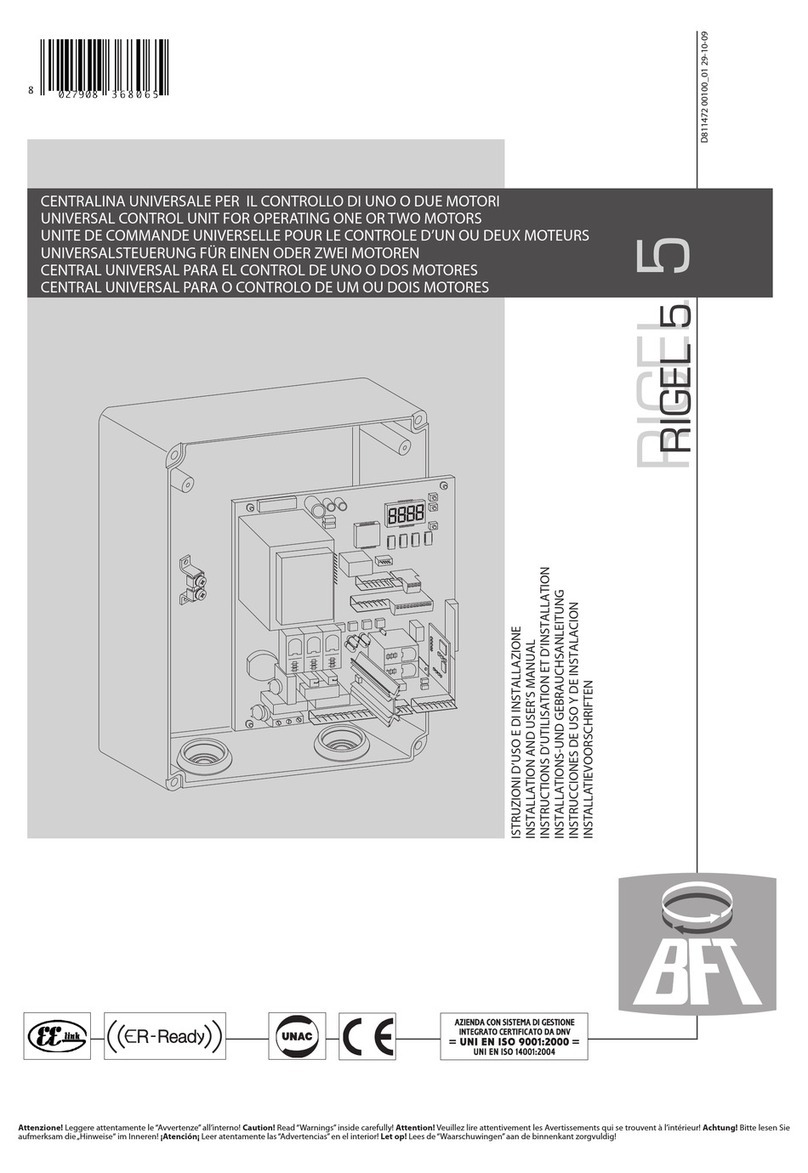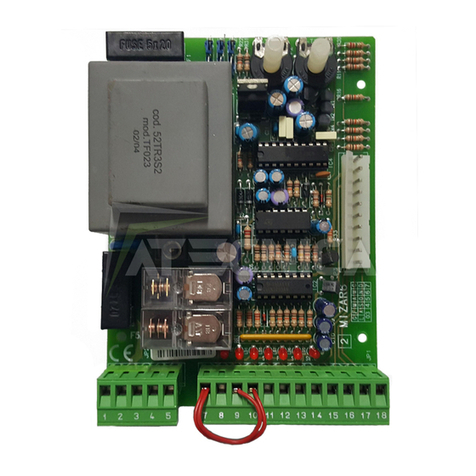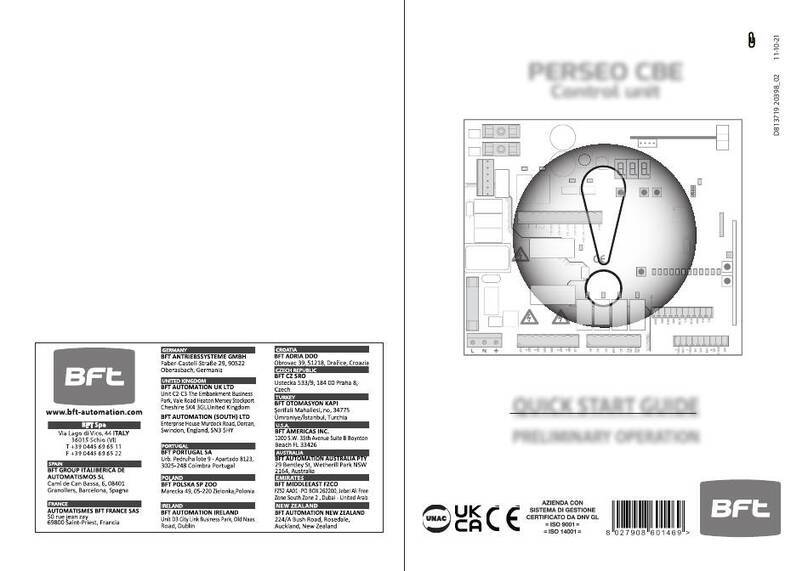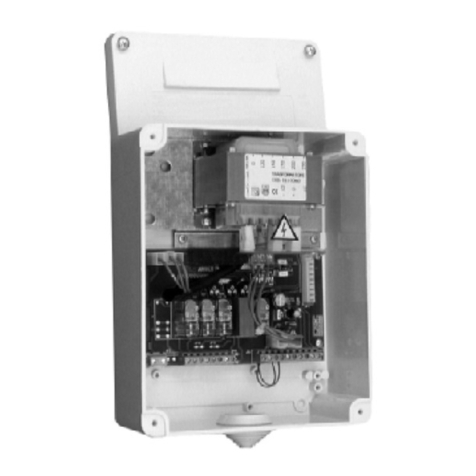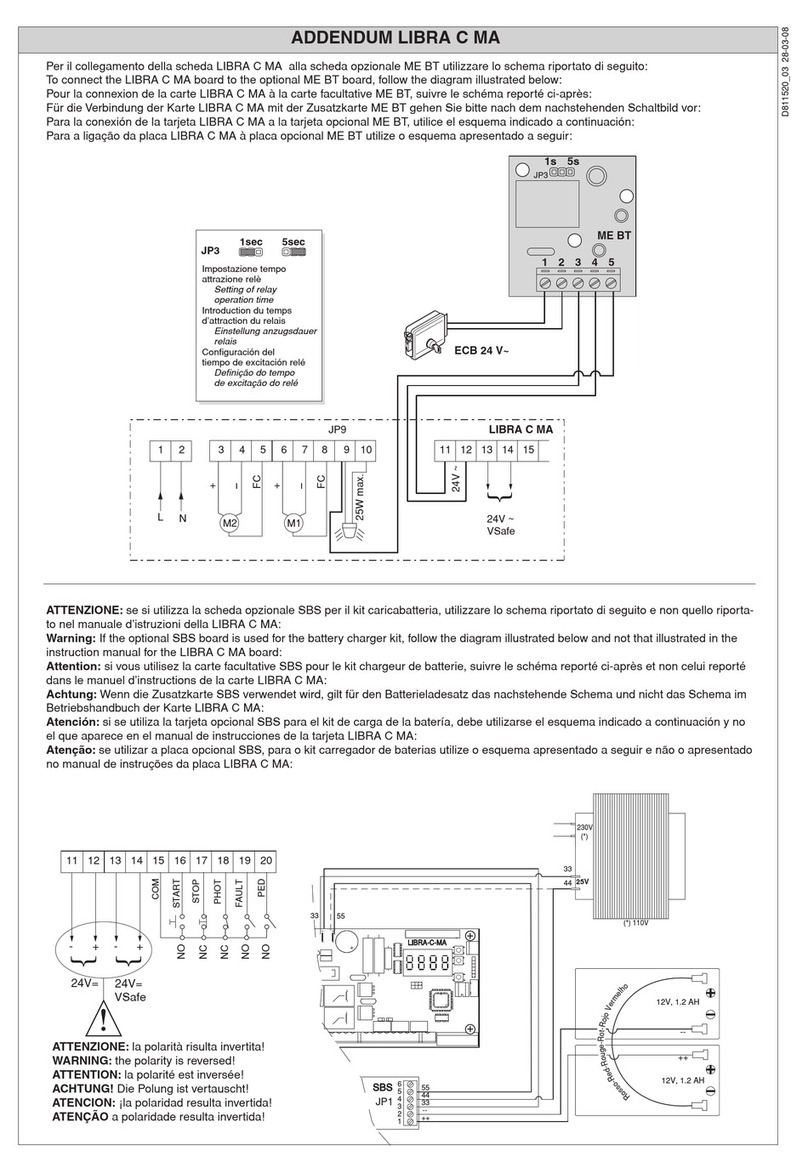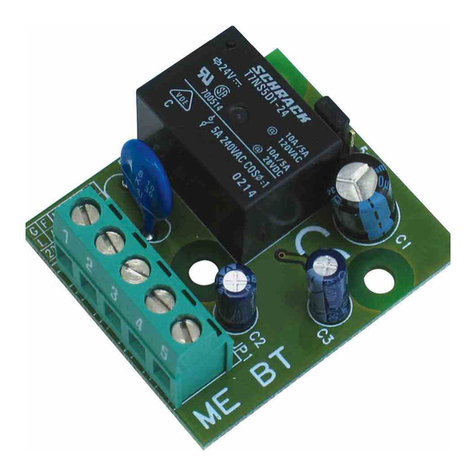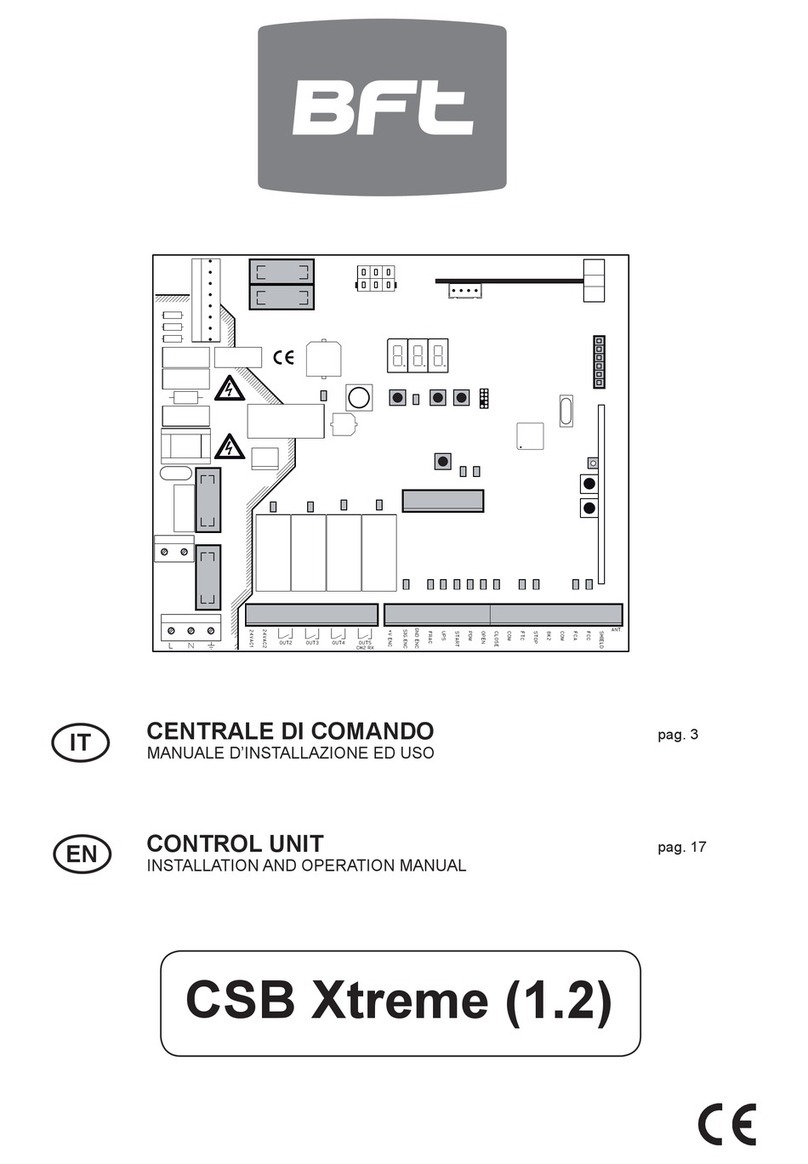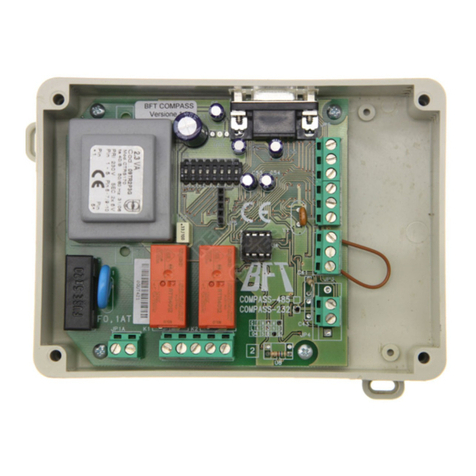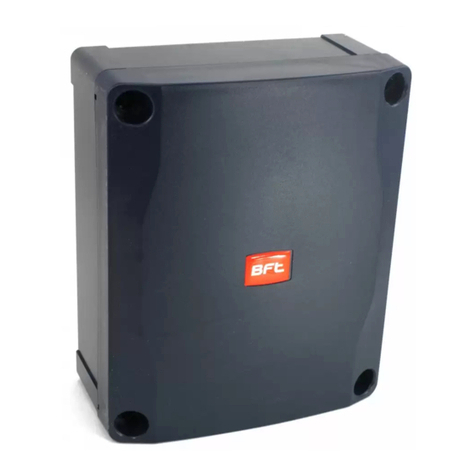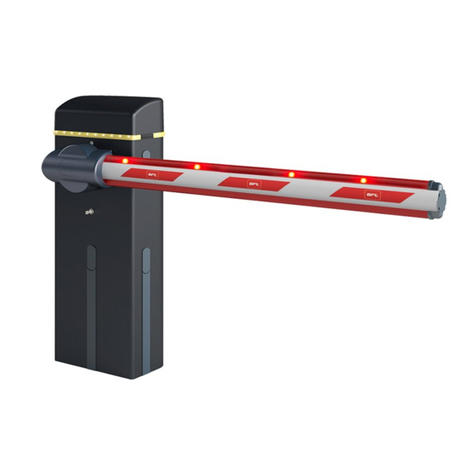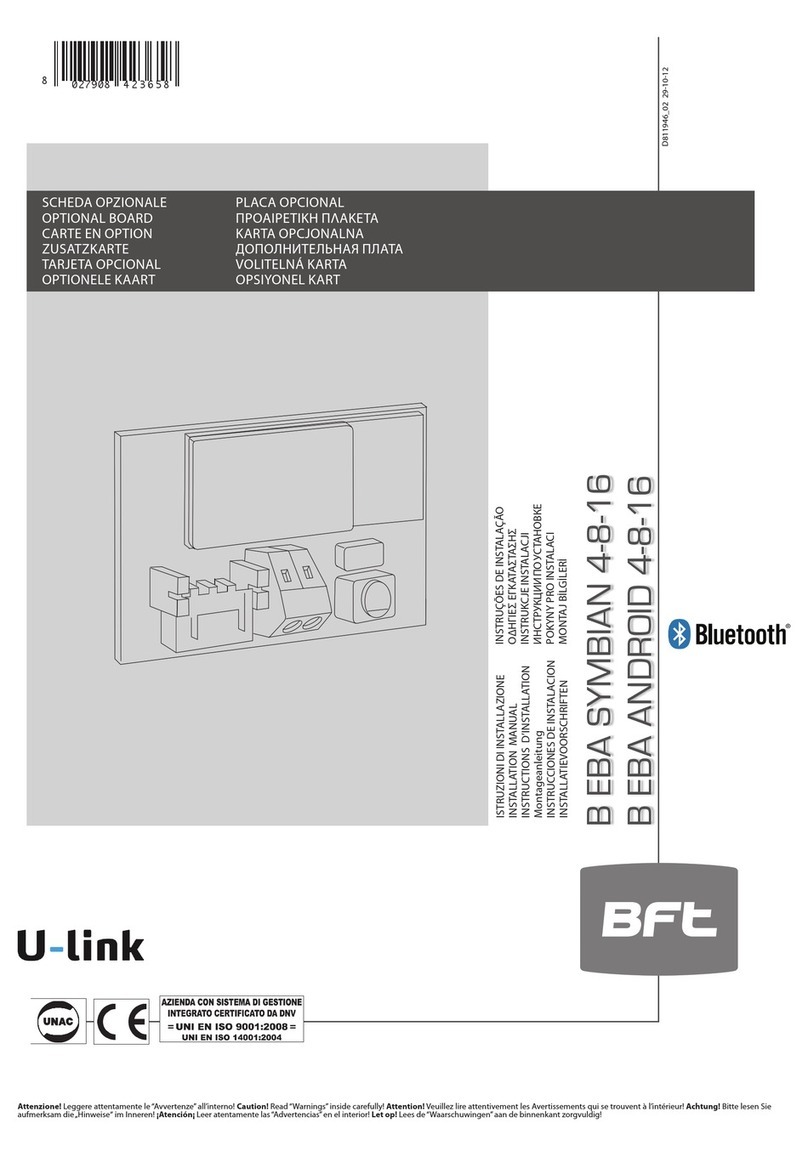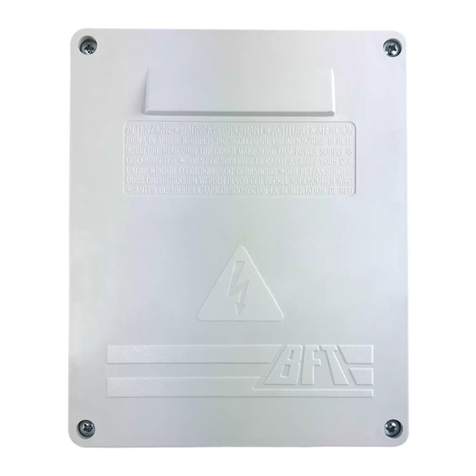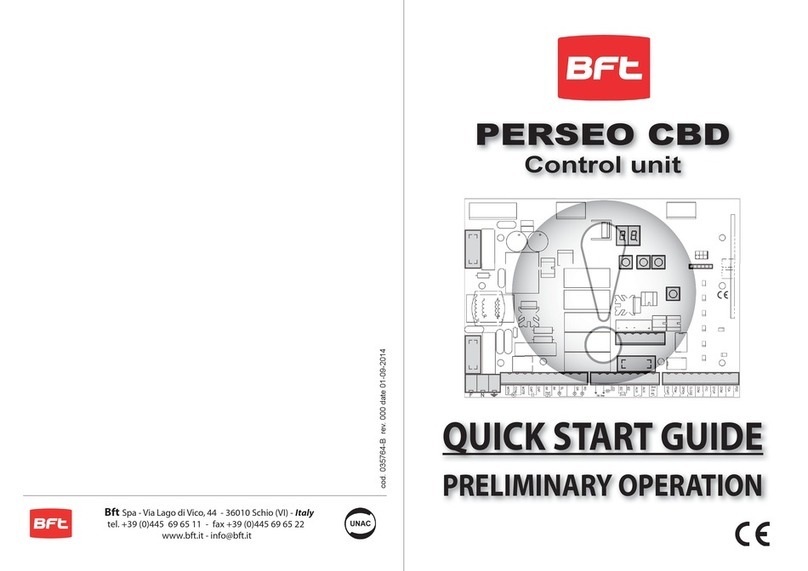
MANUALE PER L’INSTALLAZIONE ITALIANO
Nel ringraziarVi per la preferenza accordata a questo prodotto,
la ditta è certa che da esso otterrete le prestazioni necessarie al
Vostro uso. Leggete attentamente l’opuscolo “AVVERTENZE” ed il
“LIBRETTO ISTRUZIONI” che accompagnano questo prodotto in
quanto forniscono importanti indicazioni riguardanti la sicurezza,
l’installazione, l’uso e la manutenzione. Questo prodotto risponde
alle norme riconosciute della tecnica e della disposizioni relative
alla sicurezza . Confermiamo che è conforme alle seguenti direttive
europee: 2004/108/CEE, 2006/95/CEE, 98/37/CEE (e loro modiche
successive).
1) GENERALITÀ
Barriera elettromeccanica compatta adatta a limitare aree private,
parcheggi, accessi per uso esclusivamente veicolare. Disponibili
per passaggi da 3 a 5 metri. Finecorsa elettromeccanici regolabili,
garantiscono la corretta posizione d’arresto dell’asta. In caso di uso
intensivo, un sensore termico attiva la ventola di raffreddamento.
Lo sblocco di emergenza per la manovra manuale è comandato da
una serratura con chiave personalizzata.
L’attuatore viene sempre fornito predisposto per il montaggio a
sinistra.
In caso di necessità è comunque possibile invertire il senso di
apertura con semplici operazioni.
La base di fondazione mod. CBO (a richiesta) agevola l’installazione
della barriera.
Apposite predisposizioni facilitano l’installazione degli accessori
senza la necessità di effettuare forature.
2) SICUREZZA GENERALE
ATTENZIONE! Una installazione errata o un uso improprio del
prodotto, può creare danni a persone, animali o cose.
• Leggete attentamente l’opuscolo ”Avvertenze” ed il ”Libretto
istruzioni”cheaccompagnanoquestoprodotto, inquantofornisco-
no Importanti indicazioni riguardanti la sicurezza, l’installazione,
l’uso e la manutenzione.
• Smaltire i materiali di imballo (plastica, cartone, polistirolo, ecc.)
secondo quanto previsto dalle norme vigenti. Non lasciare buste
di nylon e polistirolo a portata dei bambini.
• Conservare le istruzioni per allegarle al fascicolo tecnico e per
consultazioni future.
• Questo prodotto è stato progettato e costruito esclusivamente
per l’utilizzo indicato in questa documentazione.
Usi non indicati in questa documentazione potrebbero essere
fonte di danni al prodotto e fonte di pericolo.
• La Ditta declina qualsiasi responsabilità derivante dall’uso
improprio o diverso da quello per cui è destinato ed indicato
nella presente documentazione.
• Non installare il prodotto in atmosfera esplosiva.
• Gli elementi costruttivi della macchina devono essere in accordo
con le seguenti Direttive Europee: 2004/108/CEE, 2006/95/CEE,
98/37/CEE (e loro modiche successive). Per tutti i Paesi extra
CEE, oltre alle norme nazionali vigenti, per un buon livello di
sicurezza è opportuno rispettare anche le norme sopracitate.
•
LaDittadeclinaqualsiasiresponsabilitàdall’inosservanzadellaBuona
Tecnicanellacostruzionedellechiusure(porte,cancelli,ecc.),nonché
dalle deformazioni che potrebbero vericarsi durante l’uso.
• L’installazione deve essere in accordo con quanto previsto dalle
Direttive Europee: 2004/108/CEE, 2006/95/CEE, 98/37/CEE (e
loro modiche successive).
• Togliere l’alimentazione elettrica, prima di qualsiasi intervento
sull’impianto. Scollegare anche eventuali batterie tampone se
presenti.
• Prevedere sulla rete di alimentazione dell’automazione, un inter-
ruttore o un magnetotermico onnipolare con distanza di apertura
dei contatti uguale o superiore a 3,5 mm.
• Vericare che a monte della rete di alimentazione, vi sia un
interruttore differenziale con soglia da 0.03A.
• Vericare se l’impianto di terra è realizzato correttamente: colle-
gare tutte le parti metalliche della chiusura (porte, cancelli, ecc.)
e tutti i componenti dell’impianto provvisti di morsetto di terra.
• Applicare tutti i dispositivi di sicurezza (fotocellule, coste sensibili,
ecc.) necessari a proteggere l’area da pericoli di schiacciamento,
convogliamento, cesoiamento, secondo ed in conformità alle
direttive e norme tecniche applicabili.
• Applicare almeno un dispositivo di segnalazione luminosa (lam-
peggiante) in posizione visibile, ssare alla struttura un cartello di
Attenzione.
• La Ditta declina ogni responsabilità ai ni della sicurezza e del
buon funzionamento dell’automazione se vengono impiegati
componenti di altri produttori.
• Usare esclusivamente parti originali per qualsiasi manutenzione
o riparazione.
• Non eseguire alcuna modica ai componenti dell’automazione
se non espressamente autorizzata dalla Ditta.
• Istruire l’utilizzatore dell’impianto per quanto riguarda i sistemi di
comando applicati e l’esecuzione dell’apertura manuale in caso
di emergenza.
• Non permettere a persone e bambini di sostare nell’area d’azione
dell’automazione.
• Non lasciare radiocomandi o altri dispositivi di comando alla
portata dei bambini onde evitare azionamenti involontari dell’au-
tomazione.
• L’utilizzatore deve evitare qualsiasi tentativo di intervento o ripara-
zione dell’automazione e rivolgersi solo a personale qualicato.
• Tutto quello che non è espressamente previsto in queste istruzioni,
non è permesso.
• L’installazione deve essere fatta utilizzando dispositivi di sicurezza
e comandi conformi alla EN 12978.
3) DATI TECNICI
MOOVI 30-50
Alimentazione:...............................................230V~±10% 50Hz (*)
Potenza assorbita:.................................................................300W
Motore: ................................................................. 1400 min-1 4 poli
Condensatore:......................8µF 450V (230V): 32µF 250V (110V)
Assorbimento:............................................................... 1.4 A: 2.8 A
Classe isolamento: ....................................................................... F
Temperatura intervento ventilazione:...........110 °C (avvolgimento)
Temperatura intervento disgiuntura:............ 130 °C (autoripristino)
Lubricazione riduttore: ...................................Grasso permanente
Coppia max: ........................MOOVI-30 85Nm: MOOVI-50 250Nm
Tempo apertura: ............................. MOOVI-30 4 s: MOOVI-50 8 s
Lunghezza asta (alluminio):MOOVI-30 3m max.: MOOVI-50 5m max.
Reazione all’urto (costa sensibile): Arresto o arresto ed inversione
Finecorsa:...................................... Elettrici incorporati e regolabili-
Manovra manuale:.................................... Sblocco rapido a chiave
N° manovre in 24h:................1200-(MOOVI-30): 600-(MOOVI-50)
Temperatura di esercizio: .......................................-10°C ÷ +55 C°
Grado di protezione:................................................................IP24
Peso attuatore (senza asta): ................................ 356N (~35,6 kg)
Dimensioni:.................................................................. Vedere g.1
QUADRO COMANDO ALPHA BOM
Alimentazione:...............................................230V~±10% 50Hz (*)
Assorbimento a vuoto:........................................................ 100 mA
Uscita alim. accessori:.......................................24V~ 200 mA max
Potenza max. motore: ...........................................................500W
Finecorsa:............................................................................elettrici
Tempo di lavoro: ...............................................................10s MAX
Temperatura di utilizzo:...........................................-10°C ÷ +55 C°
(*)Tensioni speciali di alimentazione a richiesta.
4) ACCESSORI OPZIONALI (Fig.17)
- Base di fondazione CBO
- Kit protezione cesoiamento KIT MOOVI PRM
- Kit colonnina ssaggio Cellula 130 KIT MOOVI 130
- Forcella ssa per appoggio asta FAF
- Gamba mobile per appoggio asta MOOVI GA (Solo MOOVI 50)
- Gamba mobile ammortizzata per appoggio asta MOOVI GAMA
- Siepe già assemblata all’asta SB
MOOVI 30-50 - ALPHA BOM Ver. 05 -9
D811471_05

